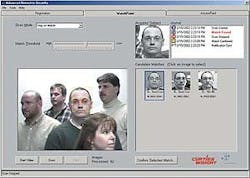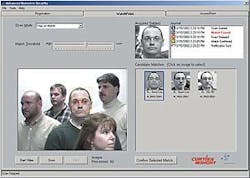by John McHale
LITTLETON, Mass. — The global war on terrorism calls for the ability to identify and track suspected terrorists and criminals at airports and sports events, as well as at military bases and nuclear power plants. The most promising technology for this is biometrics, which measures and statistically analyzes biological data such as face and eye patterns.
Two companies, Curtiss-Wright in Lyndhurst, N.J., and Inforonics in Littleton, Mass., are teaming on an electronic system able to combine several forms of biometric analysis for government, military, and commercial security.
"The primary types of biometric technology include fingerprints, eye retinas and irises, voice patterns, facial patterns, and hand measurements," explains Dave Gabree, vice president of client services at Inforonics. These technologies are for situations that "cannot allow for failure," he says.
Any one of these technologies alone is impressive, but not infallible, says Adam Albina, manager of software development at Inforonics. Combining them in one networked solution with a continuously updated database increases efficiency, he explains. By company agreement, Inforonics blends separate biometrics solutions and Curtiss-Wright licenses biometric technologies.
Curtiss-Wright is licensing a facial-recognition system from Viisage Technology, a subsidiary of Lau Acquisition Corp. in Littleton, Mass., says Phil Hamilton, a Curtis-Wright vice president of marketing. Curtiss-Wright also produces sensors and other electronics applicable to biometrics security applications in military, aerospace, and nuclear power, Hamilton says.
The new solution from Curtiss-Wright and Inforonics eases the movement of authorized personnel, while keeping out intruders, Albina says. It can foil spoofing attempts by blending facial, voice, or hand recognition, Albina says.
It also can record biometric data from intruders and update worldwide law-enforcement data-bases over secure Internet connections in real time, he says. Today, government agencies, airports, and companies can wait weeks for mailed CD-ROM data updates, Albina says.
It keeps crucial information out of the wrong hands by using either a virtual private network over Internet Protocol (IP), or with the IPSec security Internet protocol of the Internet Engineering Task Force, Albina explains.
The so-called "Biometric Intelligence Solutions" from Inforonics seamlessly integrate biometrics systems from separate vendors on the Enterprise Biometric Framework (EBF) — the core architecture of Inforonics's biometrics — Gabree says.
The EBF development environment enables biometrics applications programmers "to quickly and easily implement application logic that performs a variety of biometric functions including sample capture, biometric template production (enrollment), identification, and verification," Gabree says. Functions use the industry-standard BioAPI version 1.1 interface, he adds.
The EBF, a simple interface to low-level functions of proprietary biometrics systems, provides functionality "that normally would require a series of complicated application program interfaces (API)," Gabree says. The initial EBF uses Viisage software's ability to acquire images, generate Eigen coefficient vectors, and compare Eigen vectors stored in the database.
Experts at the U.S. Army Intelligence Battle Lab at Fort Huachuca, Ariz., are licensing Viisage technology from Curtiss-Wright for an undisclosed project, Hamilton says.
Inforonics officials say they are considering building a portable biometrics system with handheld sensor and lightweight computer for soldiers, police, and Secret Service agents to look for suspects in crowded areas, Albina says.
They are waiting for handheld computers powerful enough for facial recognition, he continues. Handhelds need processing speeds of about 1.2 gigahertz to do this, Albina explains.
Curtiss-Wright's defense electronics work is performed at the former Lau Defense facility in Littleton, Mass., while their nuclear facilities work is carried out at Curtiss-Wright's subsidiary Enertech in Brea, Calif., Hamilton says. Curtiss-Wright purchased Lau Defense from Lau Acquisition Corp. in Littleton, Mass., Hamilton adds.
For more information on the EBF and Inforonics contact the company on the World Wide Web at http://www.inforonics.com. For more information on Curtiss-Wright contact the company on the World Wide Web at http://www.curtiss wright.com.




